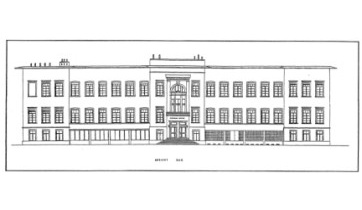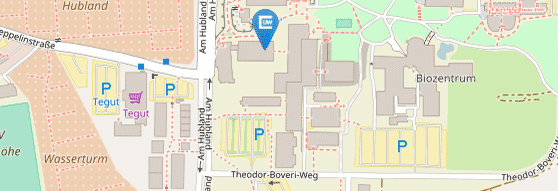History
The History of Chemistry in Würzburg
The history of academic education in Würzburg dates back as far as 1402 when a first short-lived university was founded. Almost 200 years later, in 1582, today’s Julius-Maximilians University was re-inaugurated by Prince-Bishop Julius Echter of Mespelbrunn. It consisted of the faculties of theology, philosophy, law and medicine.
The history of chemistry as an academic discipline at the University of Würzburg begins in the 18th century when the reigning Prince-Bishop wanted the professors of medicine to give chemistry lectures and to show chemical experiments to their students. In the second half of the 18th century, physics and chemistry had become increasingly independent from medicine. Finally, in 1865, Würzburg’s chemists secured their own new institute building located in the heart of the city between the residence and the cathedral.
Johann Joseph von Scherer, who had worked with Justus von Liebig in Gießen and had been appointed the first full professor of chemistry in Würzburg in 1847, moved into that building. He carried out important studies on biological pigments and proteins and is considered one of the founders of clinical chemistry. His successor was Adolph Strecker, well known for his amino acid synthesis. Chemistry in Würzburg separated from the faculty of Medicine and Strecker was the first to hold a chair of chemistry at the faculty of philosophy, from 1869 until his death in 1871. Another important organic chemist on that chair was Johannes Wislicenus who discovered the “geometrical isomerism” in lactic acid and made major contributions to stereochemistry supporting the theories of van’t Hoff. In 1885 Wislicenus was followed by the later Nobel Prize laureate Emil Fischer. Fischer stayed seven very fruitful years in Würzburg before moving on in 1892. In Würzburg he carried out the monumental studies on sugars that would yield him the Nobel Prize in 1902, and he proposed for the first time the “Lock and Key Model” to visualize substrate and enzyme interactions. Moreover, thanks to Fischer’s reputation the ministry in Munich granted funds for the construction of a new and much bigger chemistry building.
The new institute, located at the Pleicher Ring (later renamed to Röntgenring), was inaugurated in 1896. Originally planned by Emil Fischer, it was probably the best-equipped chemistry building in Germany at the end of the 19th century. Arthur Hantzsch, who was the new head of the institute, had plenty of space and excellent conditions for his research. His syntheses of pyridine and pyrrole are well known contributions to synthetic organic chemistry, but his research interests in electrochemistry and spectroscopy also pioneered physical organic chemistry. In 1903 Hantzsch left Würzburg and Julius Tafel, a scholar with E. Fischer, became head of the institute. Just like his predecessor, Tafel showed great interest in electrochemistry and electrosynthesis. The “Tafel rearrangement” and the “Tafel equation” bear his name.
Tafel’s successor in 1911 was the very renowned chemist and zymologist Eduard Eduard Buchner, who had already been awarded the Nobel Prize in 1907 for his discovery of cell-free alcoholic fermentation. He was very happy about the excellent conditions he found in Würzburg but only three years later World War I broke out and soon the institute suffered from lack of scientists and students. In 1917 Buchner was wounded in battle and died soon after. From 1918 to 1937 the situation at the institute was stable again with several extraordinary professors of chemistry and Otto Dimroth serving as the institute’s director. Dimroth was a very complete synthetic chemist, working on heterocycles and natural products and also including aspects of physical organic chemistry. The “Dimroth rearrangement” and the “Dimroth condenser” are prominent examples of his scientific legacy. In 1938 F. G. Fischer became the head of the Institute of Chemistry shortly after the natural sciences separated from the faculty of philosophy to form the new faculty of natural sciences. His research interests included physiological chemistry and natural products.
In 1961 Siegfried Hünig came from Marburg via Munich to Würzburg to succeed F. G. Fischer. Just like his predecessors he started in the building planned by Emil Fischer, and he still was the only chair professor and director of the Institute of Chemistry. However, progress in chemistry and developments at other universities had shown already that the old structures should be replaced. Hünig himself had seen the benefits of modern structures during a visit to the USA. Thus, he supported the establishment of independent Institutes of Inorganic and Physical Chemistry in 1965. Moreover, Hünig, now director of the Institute of Organic Chemistry, solved infrastructural problems by planning a new chemistry center on the outskirts of Würzburg where it’s still located today.
Of course Hünig was not only a far-sighted strategist but also an excellent researcher. His research topics included dyes, redox systems of stable radical ions, organic metals, rearrangements and electrochromics. N,N-Diisopropylethylamine, a very non-nucleophilic base for alkylations, is frequently called Hünig’s base. The second chair of organic chemistry, established in the early 1960s was held by Alfred Rödig until 1978. Rödig’s successor was Waldemar Adam who came to Würzburg from the USA in 1980. With Adam the institute became much more international and new aspects of organic chemistry were introduced since he also worked on metal-catalyzed reactions and photochemistry and cooperated with inorganic chemists, nutrition chemists and medical scientists. Adam published more than 1000 papers and was among the hundred most highly cited chemists in 2001.
When Hünig retired in 1987 he was succeeded by Gerhard Bringmann who has been contributing greatly to the chemistry of natural products for almost 30 years, being still active as a senior professor at the Institute of Organic Chemistry. After the retirement of Waldemar Adam in 2002 Frank Würthner accepted the call to the second chair of organic chemistry. In 2010 a third chair on physical organic chemistry was established and offered to Christoph Lambert. In 2017 Gerhard Bringmann was succeeded by Claudia Höbartner who is mainly interested in the chemistry of nucleic acids. In addition to the three chairs, three permanent professor positions at the Institute of Organic Chemistry are currently held by Anke Krüger, Jürgen Seibel and Matthias Lehmann.
The building planned by Hünig provided excellent research conditions for organic chemists over more than four decades. However, in 2013 the institute found a new home in a completely renovated building. In 2016 further laboratory and office space became available in a new research building for the Center for Nanosystems Chemistry headed by Frank Würthner and financed by the federal state of Bavaria. The latter particularly strengthens instrumental facilities with new units for materials characterization (X-ray diffraction and electron microscopy) and device fabrication, in addition to the already existing NMR spectroscopy and mass spectrometry facilities. Moreover, a great part of the additional space is provided for independent junior research groups to continue a long-standing tradition of affording the best support to young scientists at the beginning of their independent careers.




